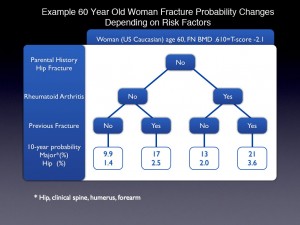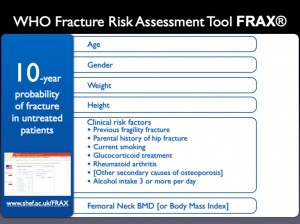Fracture risk assessment has been a part of overall evaluation of osteoporosis. However, the challenge was trying to systematically measure one’s risk. A scientific committee of the World Health Organization undertook the task. They developed a tool based epidemiologic data from research studies across the world and tested for validity in thousands of other subjects.

The fracture assessment tool duped “FRAX” was released in 2008. Subsequently, updates to the calculator and expansion of countries have been added.
FRAX includes your height, weight, age, sex, and answering either yes or no for the following risk factors:
- Previous fracture
- Hip fracture in your mother or father
- Current smoking
- Steroid use
- Rheumatoid arthritis
- Secondary osteoporosis (other causes)
- Alcohol 3 or more units a day

If you have had a bone density scan, the result of your DXA scan of the femoral neck skeletal site is used to finish the calculation. If you input bone density, “secondary osteoporosis” is not used in the model for calculation of your risk of fractures.
If you have not had a bone density or do not know the results, an estimate of your fracture risk is based on your body mass index calculated from your height and weight.
You can go to the website link below and use the calculator or discuss during the your next visit with your doctor.
Your 10-year probability of fracture results are a useful starting point for determining your overall management plan. The National Osteoporosis Foundation (NOF) Treatment Guidelines utilize results of FRAX to identify individuals with low bone mass at high-risk for fracture that may benefit from treatment with an osteoporosis medicine.
Other Resources:
FRAX calculator website
http://www.shef.ac.uk/FRAX/
